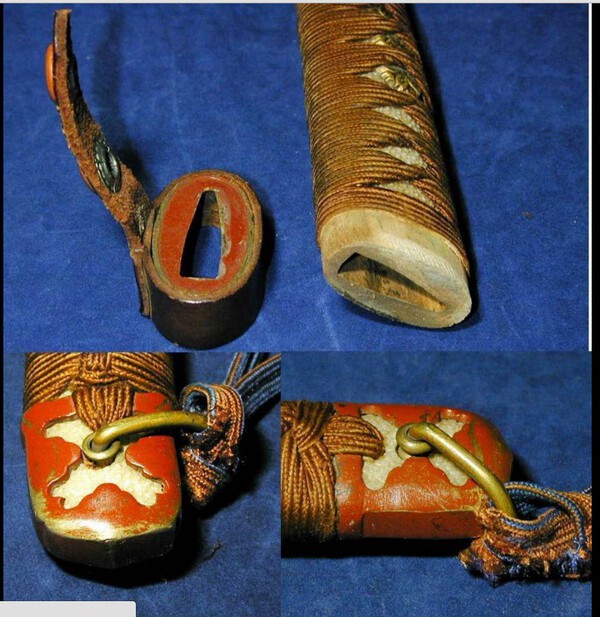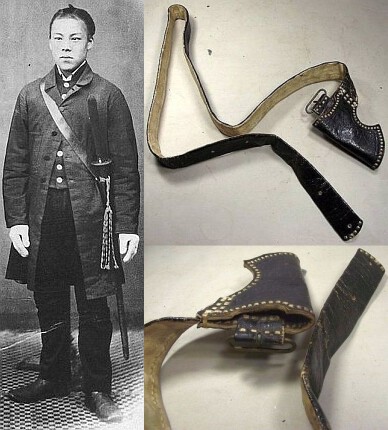-
Posts
1,686 -
Joined
-
Last visited
-
Days Won
12
Content Type
Profiles
Forums
Events
Store
Downloads
Gallery
Everything posted by Dave R
-
Ohmura has these down as being Gunzoku tsuba.
-
Well spotted Mr Pennington, I had missed that clue! .... and still probably just about worth what it went for, given the condition of the mounts. Photo from the original Ebay post below
-
I think a decision could only be made with the piece in hand, there is always hidden detail not available from a photo. I am perhaps overly sceptical, but that is very much because of what I have seen in the years I have been collecting. I suggest reading and rereading the very carefully worded description below the the main block of the posting.
-

Army Purchase Civilian Swords Of Wwii?
Dave R replied to george trotter's topic in Military Swords of Japan
A lot would depend on the quality of the blade bought in. The original appeal made it clear that the very best would not be taken in, but sent back to be preserved for posterity. "Swords suitable as Gunto, coming with a minimum blade length of 54.5 centimetres (21.5") will be bought up at fair prices. However, please understand that those valued at more than 500 Yen and naturally those that reveal themselves to be of national treasure class or of particular historical value in the preliminary acceptance Shinsa screening will need to be excluded, and we ask that they be kept in your custody to be preserved on behalf of the nation. Please be sure to clearly tag with name and address the blades you submit" There would also be a lot of "bundle swords" kaza uchi mono brought to the buyers, and Shinto and Shin Shinto blades of no great quality but decent enough for war time use. I have reason to believe that one of my own falls into that category, an old mumei, possibly Koto blade, that arrived in a wreck of a Shin Gunto koshirae. I have little doubt that the selling price to an officer would reflect the adjudged quality of the blade. -
Then again, our last school shooting was in 1996! "lol"
-
Reminds me of the time in a city in England. There was a .22 rimfire cartridge found in the gutter of the street. Well they called in the bomb squad and roped off the entire block for the day while they "secured" the dangerous .22 cartridge...lol Really? Sounds like Fox news to me. I live in the UK and we are not THAT sensitive.
-
NCO sword with a modified officers scabbard. A bit of a shotgun job in my opinion.....
-
I think they are replacements for the original. The join is usually hidden within the kabuto-gane. Could be done within the service life of the sword, or later.
-

Looking For Info On This Nihonto
Dave R replied to Bob-K's topic in General Nihonto Related Discussion
My thought as well. Here is a composite picture of the Nakago of one of mine. No stamps or engraving, cursory Nakago-jiri, but decently shaped. -
Well done! Thanks for sharing this, you have saved the sword.
-
Any and every "new owner" will want a look at the Nakago before parting with any money. It might be best for the hilt to come off carefully and at leisure, rather than hurriedly in a market environment. You never know what will be revealed either..
-
I think that is a Sun faded red... Some dyes are very fugitive, especially poorly mordant-ed (fixed) vegetable (natural) dyes.
-

Attention Mantetsu Owners: A Survey
Dave R replied to Bruce Pennington's topic in Military Swords of Japan
Interesting, Mantestu have a non-flat Nakago-Mune? Very odd indeed. Are you sure about that. -
Not removed since 1945 perhaps. These leather covers were put on to preserve the original tsuka/hilt in action, and were expected to be removed out of "the field". Japanese blades were meant to undergo a regular maintenance routine, which involved removal of the hilt for oiling and uchiko. It's a bit like a motor enthusiast saying, "no one ever popped the bonnet/hood" on this car......
-

Looking For Info On This Nihonto
Dave R replied to Bob-K's topic in General Nihonto Related Discussion
Somehow, you have managed to miss most of the useful diagnostic features. But it looks to be a Japanese blade, probably non traditional. More useful would be pictures of the overall shape, the end of the tang and both sides of the full tang, blade to the top. -
One of the things I don't like about Kai-Gunto is the wrap. I know why they went for Hira-Maki, it's the old Tachi style and very posh, but it always looks a bit insecure, and not as good a grip as Hineri-Maki. It's the tsukamaki I tried on my first restoration when a teenager, and it shifts like mad under the hand...... Probably one reason why the Navy insisted on a full same cover to the tsuka, the integrity of the ito is then not such an issue.
-

Can Anyone Help Me Identify This Maybe Let Me Know What It Is
Dave R replied to Sjcso214's topic in Military Swords of Japan
The giveaway that it's an adapted shirasaya is that it has flattened sides, rather than smoothly rounded. Best guess, is an older blade in shirasaya, given a fast makeover to make it usable in the field Probably done quite late in the war, when things had got very tight. -
A vexed question, because the answer can only be ... Sometimes. With the iron saya being regulation, I would say that there was some intent and effort to achieve ease of fitting, but I doubt that interchangeability was a high priority. You have the same thing with Western military blades. Even the straight bladed British 1898 does not swap without a bit of tweaking.
-
I see no issues with this sword at all. Regarding plain mounts with same under the ito, this is a koshirae I bought from Japan. Originally just to use as a model for when I repair and reconstruct.
-
Simple test, give the sword a good shake, does it feel firm, or rattle. Parts swapping does go on, but is usually done when the original mounts are badly degraded on an otherwise good blade... And most often, traditional mounts retro fitted to an old blade found in Gunto mounts. Swapping is also usually a quick and dirty job, done without care to move a piece on quickly for a profit. Myself, I remount blades that have been stripped, so that they are swords again, rather than bare blades. There are a lot of orphan blades out there, that need the love!
-
Rare, perhaps. Very nice Navy mounts, and I think Yasukuni To are rare and desirable enough not to need dressing up. My guess is either a presentation piece, or someone wanted a good blade, and not a rust-resistant one. Shore based Navy perhaps.
-
Lots of WW2 Gunto turn up with iron tsuba.
-
Blade and mounts were traditionally made by different craftsmen, a possible exception being tsuba. Some tsuba are believed to have been made by sword smiths, or at least in their workshops, out of blade scrap and cut off's. Ferrous and non ferrous metalwork are different enough skills that they are rarely practised by the same smith.
-
Some interesting adaptions during that period, including Toppai koshirae. You might like this one... I also have files for the Bakumatsu period as well. (I am a complete Geek.)
-
Going by the photo's, I see forging flaws, a hira-zukuri blade, and a nakago that is made from the blade after shortening. Best guess is a cut down wakizashi of unknown date, and no great value. Nonetheless, you have a nihonto, and it all depends on what you paid for it. The killer here is whether it has its original point, or has been cut from further back in the blade. Time for some serious uchiko!







